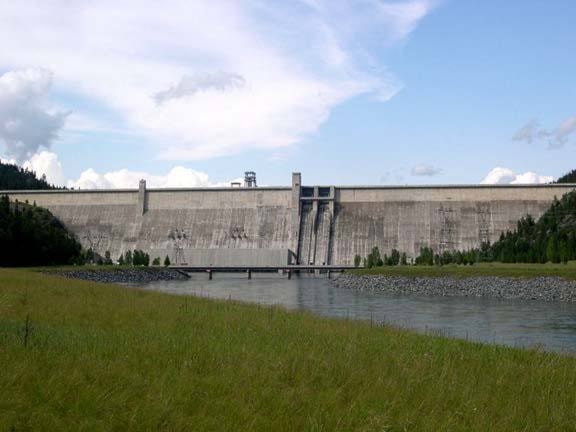Good news for boaters: the water level in Koocanusa reservoir will be within 10 feet of full by the end of June and stay in that range until September.
An early peak runoff from snow pack into the Kootenay River means Koocanusa is already 10 feet higher than it was this time last year, according to experts at the U.S. Army Corps of Engineers, which operates Libby Dam downstream of Koocanusa.
Popular with recreational boaters, Koocanusa feeds the Kootenay River into the Libby Dam in Montana. The dam controls flood risk downstream on the Kootenay River as it passes through Bonners Ferry, Idaho and into the West Kootenay.
Koocanusa reservoir will probably reach an elevation of 2,450 feet by the end of June. The reservoir is considered full at 2,459 feet.
By the end of July, the levels will reach around 2,453 feet, and stay in that range until the end of September, when releases from Libby Dam will be increased to bring Koocanusa down to 2,449 feet by September 30.
"It looks like we will have these elevations at the end of June instead of waiting until the middle of July to get there," said Joel Fenolio, Upper Columbia Senior Water Manager with the Corps.
Fenolio said Koocanusa was already seeing a healthy inflow by the middle of May.
"It looks like we have seen the peak inflow for the year," he said.
This year, the snow pack in the Kootenay basin was slightly higher than normal, according to Kelvin Ketchum, BC Hydro's Generation System Optimization Portfolio Manager.
"The snow pack and run off overall is pretty much average this year. In the Kootenay basin, it is slightly above average, but still 10 to 20 per cent less snow pack than last year," said Ketchum.
He is a little more cautious about making predictions for Kootenay River operations.
“Kootenay Lake is already at or near peak levels, four feet below full pool,” he said. “Of course, who knows? We could still get huge amounts of rainfall in June.”
That’s exactly what happened in 2012. On top of a larger than average snow pack, the Kootenays saw huge rainfall in June, resulting in widespread flooding.
That month, Cranbrook had 9.6 centimetres of rain, when the average for June is 5.3 cm. Fernie had 15.5 cm, up from a monthly average of 9.9 cm. Meanwhile, Nelson had 9.6 cm of rain, up from an average of 8.1 cm.
Kootenay Lake was at its highest levels in 38 years, peaking at 1,753.8 feet. Bonners Ferry, Idaho reached 1,766.6 feet, which is 2.5 feet above flood level.
To reduce the flood, a rare agreement between Canada and the United States allowed the Corps to let Koocanusa go a foot above its full level, to just above 2,460 feet.
That saved 0.3 feet in Kootenay Lake and 1.4 feet at Bonners Ferry.
“Last year we made all sorts of efforts to provide flood control,” said Ketchum.
“2012 was a huge water year but we had pretty successful results,” he went on, adding that people were affected by flooding, but not nearly as much as they could have been if Libby Dam and Duncan Dam on Kootenay Lake weren’t there.
In that case, Ketchum said, Kootenay Lake would have been another 6.5 feet higher, drastically impacting West Kootenay communities.
The river at Bonners Ferry would have reached 1,775 feet, 11 feet above flood stage.
Last year’s flooding has had a “hangover” effect on Koocanusa, namely in the amount of debris in the reservoir.
Diane Tammen, BC Hydro’s East Kootenay community relations manager, said that each year the company spends between $75,000 and $100,000 to remove floating debris from the reservoir.
Last year, BC Hydro doubled that amount, spending $185,000 removing flood debris over the course of the summer.
Already this year, contractors are out on Koocanusa beginning to remove debris and getting the reservoir ready for recreational boaters.
Meanwhile, the U.S. Fish and Wildlife Service is continuing to work to help the endangered Kootenay white sturgeon downstream of Libby Dam.
The largest freshwater fish in North America, white sturgeon can grow to 12 feet in length and weigh up to 1,000 pounds in their 100-year life span.
With an estimated 1,000 wild adult fish remaining, the Kootenay white sturgeon was listed as endangered in Canada in 2003, after nine years on the U.S. endangered list.
The fish, which don’t begin reproducing until about age 30, have been in decline since the 1950s.
Biologists are trying to entice the fish to spawn upstream of Bonners Ferry, where the river bed is covered with gravel, instead of downstream of Bonners Ferry where the sandy, silty river bed suffocates the eggs.
So far, experiments have failed to see the sturgeon spawn further upstream. This year, the Corps are increasing the outflow from Libby Dam to its maximum for two separate weeks to see if that draws the sturgeon further upstream.
